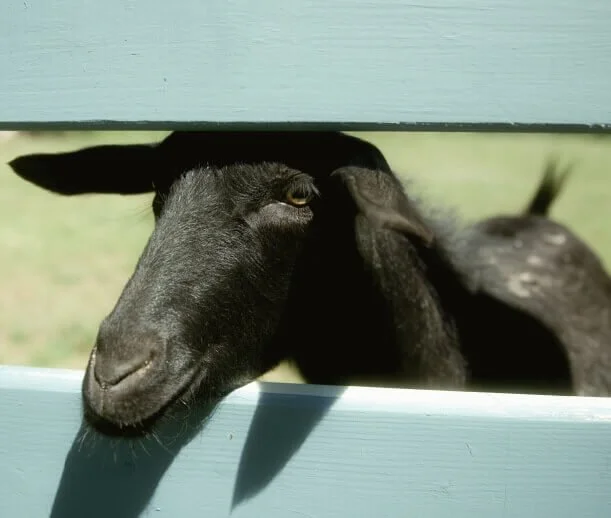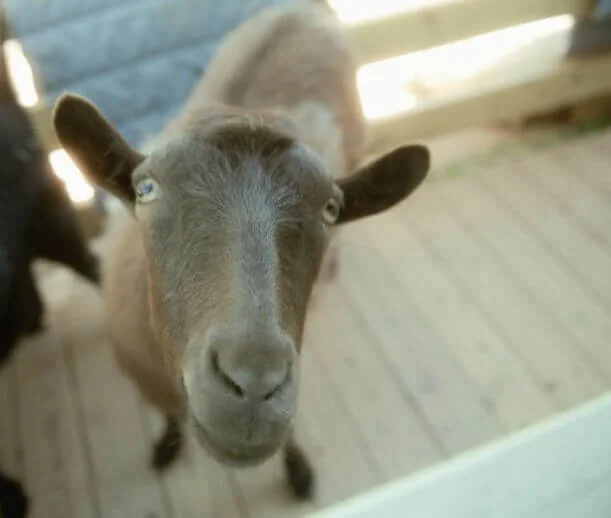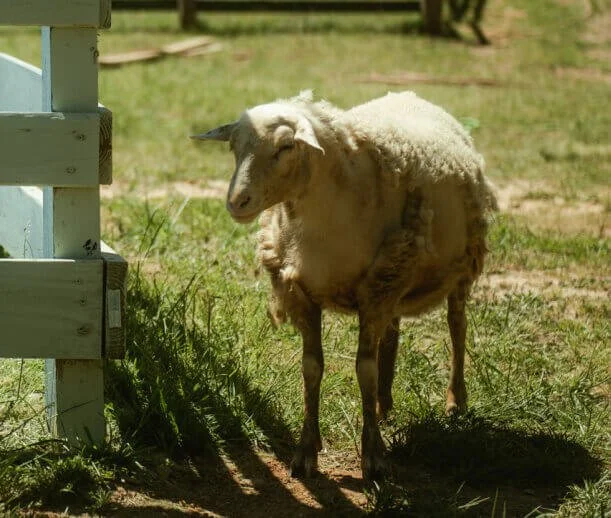
Meet The Goats
& Sheep

What can we say about goats?
They have a deserved reputation of being hard-headed and curious to a fault.
It’s their inquisitive nature that drives them to explore, and for a goat exploring means they use their mouths… leading to the myth that goats will “eat anything”.
The truth is—they’re very picky eaters!
In the end, goats are smart and loving creatures who deserve the best in life.
Sadly, since their domestication some 10,000 years ago, most goats have been used for their milk, meat, fur, and skin. Meaning they’re slaughtered well before their natural life span of 15-18 years.
Buckey
Buckey
Buckey belongs to the breed that is commonly known as fainting goats.
These goats suffer from a genetic condition called myotonia congenita which causes their legs to seize or stiffen when startled or excited.
Unfortunately, this condition means that they are one of the most desirable breeds for “meat” farmers because the process of repeated stiffening of the legs builds up more muscle tissue than in other types of goats.
Luckily, we were able to rescue this uniquely precious boy from that fate. And, can we just say…Buckey might better have been named “Buster”?
He has the uncanny knack for finding endless ways to tinker with everything he can manage to get into—and it’s a lot! But we must also admit, it is one of his most endearing qualities!
Baker
Baker
Our other resident goat, Baker, is also a myotonic or fainting goat.
He is differentiated from most others by his cashmere coat, which is quite a rarity. If used commercially, Baker’s coat would raise his value. But, to us, he is valued simply for being a member of our treasured extended family.
Along with his partner in crime, Buckey, Baker likes to pursue mischief as his primary activity! But we don’t hold it against him.
He is very social and especially good around and friendly towards children. Visitors to the sanctuary enjoy interacting with the goats and feeding them their favorite treats—animal crackers!
When it comes to their interactions with visitors to the property, they truly are more like a couple of puppies than goats.

As flock animals, sheep are most comfortable in large numbers.
The stronger among them will defend weaker ones when threatened. This type of behavior exemplifies their ability to experience a range of complex emotions, including sympathy, fear, grief, and joy.
They also display high levels of intelligence. If presented with the challenge, they’re even capable of navigating an intricate maze.
Sheep are used commercially for their flesh and fiber. They are slaughtered at varying ages, most commonly as baby lambs, at 2-15 months of age.
None, unless kept as pets or rescues, will live anywhere near their life expectancy of 10-12 years.
Daffy
Daffy
Daffodil the little lamb…
has one of the most horrific stories of all our rescues.
After a good Samaritan found a lost dog on the road and returned him home, she spotted poor Daffodil lying in the backyard with what would otherwise have been mortal wounds to her body from a dog attack.
The homeowners were uninterested in providing the care she desperately needed to save her life. Thankfully they surrendegred her.
The good Samaritan contacted one of our top volunteers who saw that Daffodil was rushed to an emergency veterinarian and subsequently transferred to the N.C. State University School of Veterinary Medicine.
Despite the emergency care, it wasn’t at first clear whether or not Daffodil would make it. But, after a long and difficult two weeks of waiting, we finally received word that she was out of the woods and would be coming home!
We love our precious Daffodil (affectionately known as Daffy), and we’re so pleased to be able to offer her forever care here at the sanctuary.
Have a question about our sponsorship program?




